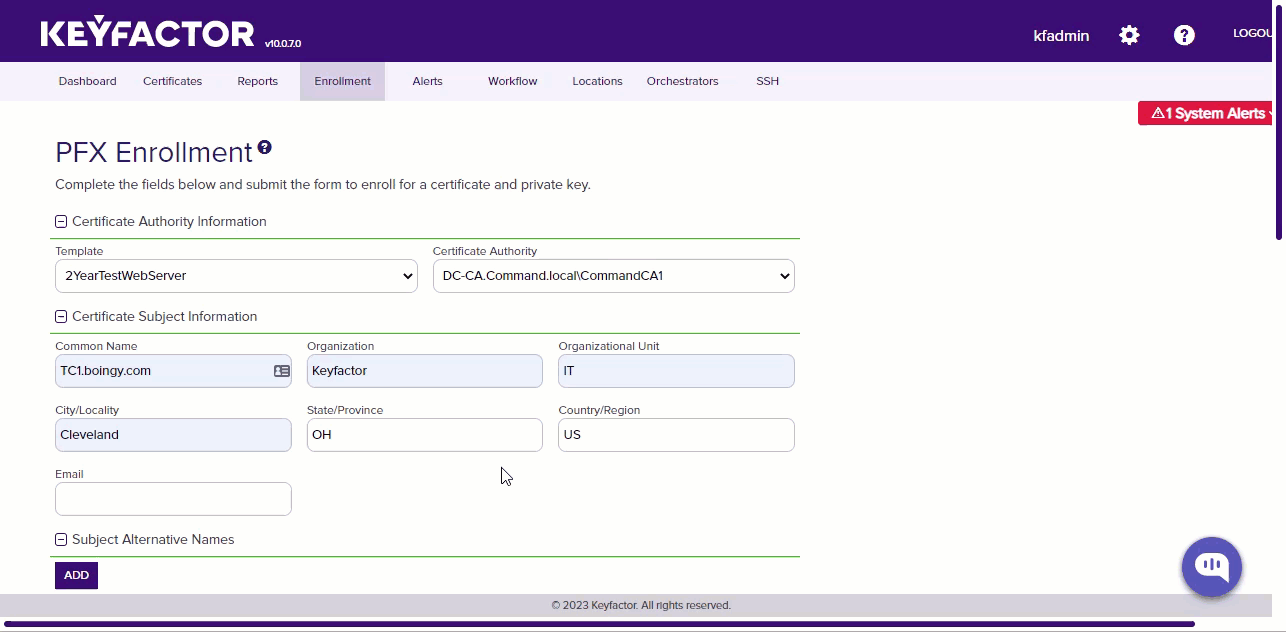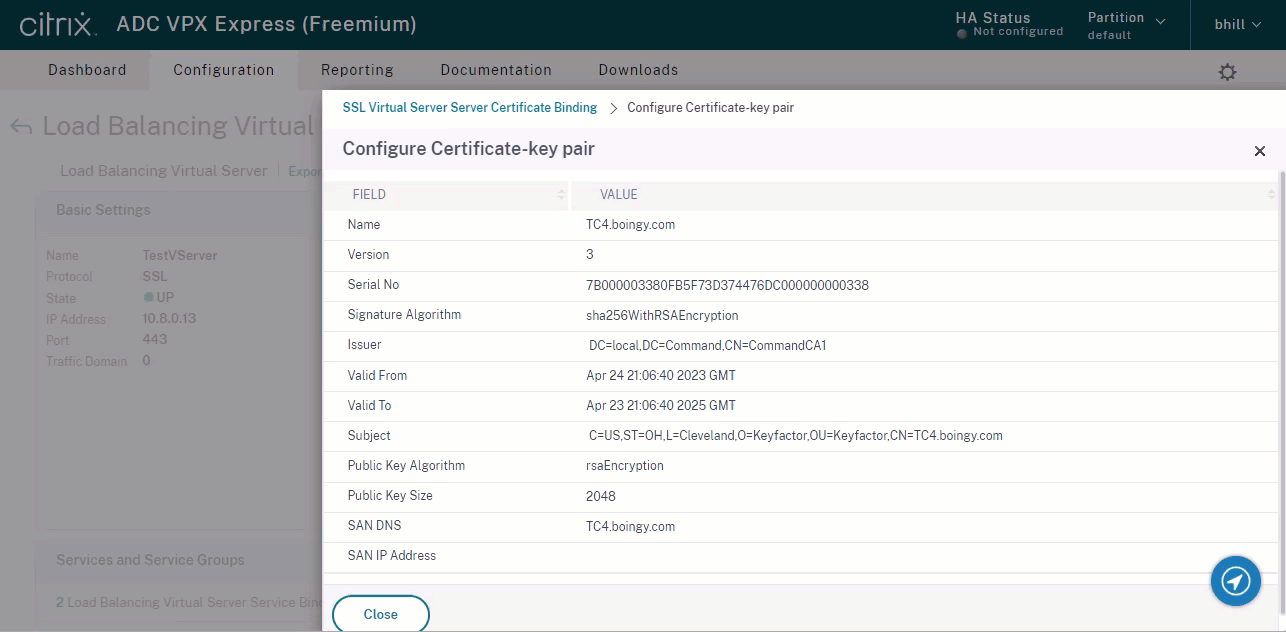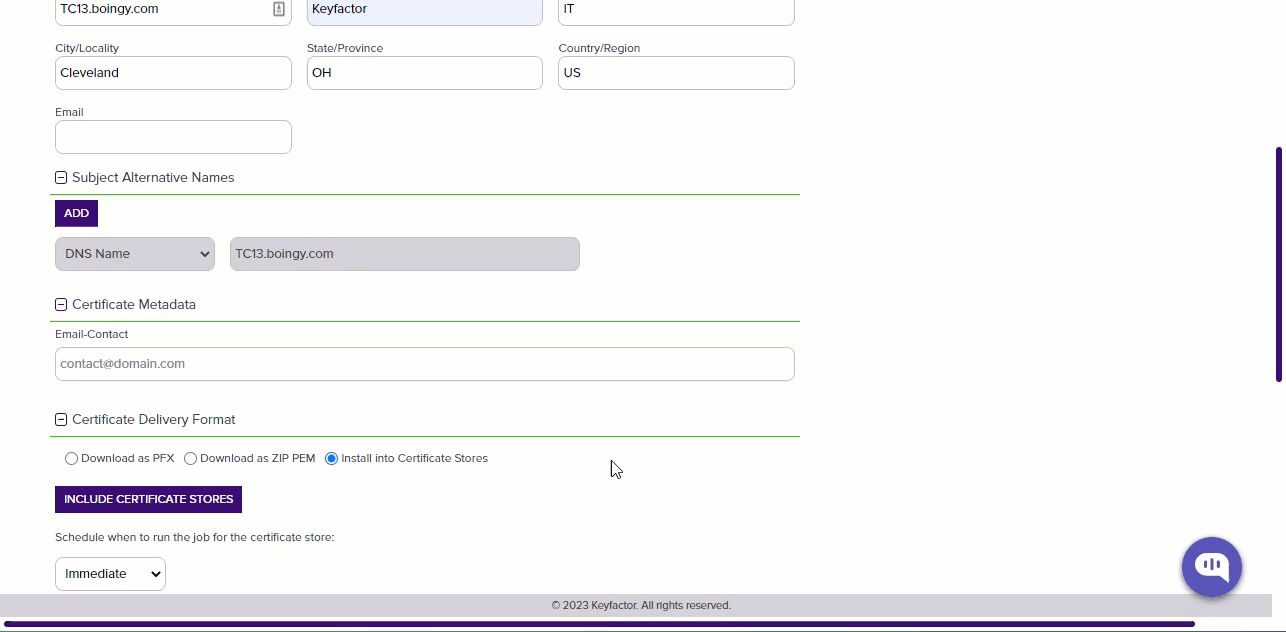Orchestrator to manage certificates and keys on one to many VServers in Netscaler. The integration supports Enrollment, Renewal, Inventory and Remove from Store.
This repository contains a Universal Orchestrator Extension which is a plugin to the Keyfactor Universal Orchestrator. Within the Keyfactor Platform, Orchestrators are used to manage “certificate stores” — collections of certificates and roots of trust that are found within and used by various applications.
The Universal Orchestrator is part of the Keyfactor software distribution and is available via the Keyfactor customer portal. For general instructions on installing Extensions, see the “Keyfactor Command Orchestrator Installation and Configuration Guide” section of the Keyfactor documentation. For configuration details of this specific Extension see below in this readme.
The Universal Orchestrator is the successor to the Windows Orchestrator. This Orchestrator Extension plugin only works with the Universal Orchestrator and does not work with the Windows Orchestrator.
Citrix Netscaler Universal Orchestrator is supported by Keyfactor for Keyfactor customers. If you have a support issue, please open a support ticket via the Keyfactor Support Portal at https://support.keyfactor.com
To report a problem or suggest a new feature, use the Issues tab. If you want to contribute actual bug fixes or proposed enhancements, use the Pull requests tab.
The minimum version of the Keyfactor Universal Orchestrator Framework needed to run this version of the extension is 10.1
The Keyfactor Universal Orchestrator may be installed on either Windows or Linux based platforms. The certificate operations supported by a capability may vary based what platform the capability is installed on. The table below indicates what capabilities are supported based on which platform the encompassing Universal Orchestrator is running.
| Operation | Win | Linux |
|---|---|---|
| Supports Management Add | ✓ | ✓ |
| Supports Management Remove | ✓ | ✓ |
| Supports Create Store | ||
| Supports Discovery | ||
| Supports Reenrollment | ||
| Supports Inventory | ✓ | ✓ |
This orchestrator extension has the ability to connect to a variety of supported PAM providers to allow for the retrieval of various client hosted secrets right from the orchestrator server itself. This eliminates the need to set up the PAM integration on Keyfactor Command which may be in an environment that the client does not want to have access to their PAM provider.
The secrets that this orchestrator extension supports for use with a PAM Provider are:
| Name | Description |
|---|---|
| ServerUsername | The user id that will be used to authenticate into the server hosting the store |
| ServerPassword | The password that will be used to authenticate into the server hosting the store |
| StorePassword | The optional password used to secure the certificate store being managed |
It is not necessary to use a PAM Provider for all of the secrets available above. If a PAM Provider should not be used, simply enter in the actual value to be used, as normal.
If a PAM Provider will be used for one of the fields above, start by referencing the Keyfactor Integration Catalog. The GitHub repo for the PAM Provider to be used contains important information such as the format of the json needed. What follows is an example but does not reflect the json values for all PAM Providers as they have different "instance" and "initialization" parameter names and values.
General PAM Provider Configuration
To use a PAM Provider to resolve a field, in this example the Server Password will be resolved by the Hashicorp-Vault provider, first install the PAM Provider extension from the Keyfactor Integration Catalog on the Universal Orchestrator.
Next, complete configuration of the PAM Provider on the UO by editing the manifest.json of the PAM Provider (e.g. located at extensions/Hashicorp-Vault/manifest.json). The "initialization" parameters need to be entered here:
"Keyfactor:PAMProviders:Hashicorp-Vault:InitializationInfo": {
"Host": "http://127.0.0.1:8200",
"Path": "v1/secret/data",
"Token": "xxxxxx"
}After these values are entered, the Orchestrator needs to be restarted to pick up the configuration. Now the PAM Provider can be used on other Orchestrator Extensions.
With the PAM Provider configured as an extenion on the UO, a json object can be passed instead of an actual value to resolve the field with a PAM Provider. Consult the Keyfactor Integration Catalog for the specific format of the json object.
To have the Server Password field resolved by the Hashicorp-Vault provider, the corresponding json object from the Hashicorp-Vault extension needs to be copied and filed in with the correct information:
{"Secret":"my-kv-secret","Key":"myServerPassword"}This text would be entered in as the value for the Server Password, instead of entering in the actual password. The Orchestrator will attempt to use the PAM Provider to retrieve the Server Password. If PAM should not be used, just directly enter in the value for the field.
The Citrix ADC Orchestrator remotely manages certificates on the NetScaler device. Since the ADC supports services including: Load Balancing, Authentication/Authorization/Auditing (AAA), and Gateways, this orchestrator can bind to any of these virtual servers when using unique virtual server names for each service.
The NetScaler user needs permission to perform the following API calls:
| API Endpoint | Methods |
|---|---|
| /nitro/v1/config/login | post |
| /nitro/v1/config/lbvserver | get |
| /nitro/v1/config/sslcertkey | get, update, add, delete |
| /nitro/v1/config/sslcertkey_service_binding | get, update, add, delete |
| /nitro/v1/config/systemfile | get, add, delete |
Here is a sample policy with Min Permissions:
- Action: Allow
- Command Spec: (^stat\s+(cr|cs|lb|system|vpn))|(^(add|rm|show)\s+system\s+file\s+.)|(^\S+\s+ssl\s+.)|(^(show|stat|sync)\s+HA\s+.)|(^save\s+ns\s+config)|(^(switch|show)\s+ns\s+partition.)
- Upgrade From v1.0.2 to v2.0.0
- In the Keyfactor Command Database, run the following SQL Script to update the store types and store information Upgrade Script
-
Direct PFX Binding Inventory
- In NetScaler you can directly Bind a Pfx file to a Virtual Server. Keyfactor cannot inventory these because it does not have access to the password. The recommended way to Import PFX Files in NetScaler is descibed in this NetScaler Documentation
-
Specifiy Multiple VServers and Sni Flags
- When Binding to Multiple VServers and using Multiple SniFlags, you must use a comma separated list of values as described in Test Case 13 in the Test Cases Section. This will change in future version, so each binding is a store in Keyfactor.
-
Down Time When Replacing Certs
- The orchestrator uses NetScaler recommended methods to replace bound certs which creates a sub second blip of downtime. There is currently no way around this if you want readable keypair names.
-
Removing Certs from Store
- As defined in Test Cases 5 and 13 below, certificates that are bound to a server will not be removed. This was done to limit the possibility of bringing production servers down. Users are currently required to manually unbind the certificate from the server and then remove the cert using Command. This requirement may change in a future version.
-
Renewals
- The renewal process will find the thumbprint of the cert on all VServers and renew them in all places. See test cases #6 and #10 in the Test Cases section.
-
AutoSave Config
- A new config.json file in the extension folder contains the 'AutoSaveConfig' flag with a default value of 'N'. When this flag is set to 'Y', successful configuration changes made by a management job will be automatically saved to disk; no interaction with the Citrix ADC UI is necessary.
NOTE: Any changes in-process through the Citrix ADC UI will also be persisted to disk when a management job is performed and the AutoSaveConfig flag is set to 'Y'.
-
Support for Virtual Authentication Servers & Gateways
- When performing management operations to either of services, Users may enter the specific VServer name to complete the operation.
NOTE: If multiple VServers share the same Alias, all VServers that share that alias will be updated.
-
Supports optional linking of added certificates to issuing CA certificate if issuing CA is already installed in the managed Netscaler instance.
Cert Store Type Settings
Basic Settings
| CONFIG ELEMENT | VALUE | DESCRIPTION |
|---|---|---|
| Name | Citrix ADC | A descriptive name for the extension. Example: CitrixAdc |
| Short Name | CitrixADC | The short name that identifies the registered functionality of the orchestrator. Must be CitrixAdc. |
| Custom Capability | Unchecked | Store type name orchestrator will register with. |
| Supported Job Types | Inventory, Add, Remove | Job types this extension supports |
| Needs Server | Checked | Determines if a target server name is required when creating store |
| Blueprint Allowed | Unchecked | Determines if store type may be included in an Orchestrator blueprint |
| Uses PowerShell | Unchecked | Determines if underlying implementation is PowerShell |
| Requires Store Password | Unchecked | Determines if a store password is required when configuring an individual store. |
| Supports Entry Password | Unchecked | Determined if an individual entry within a store can have a password. |
Advanced Settings
| CONFIG ELEMENT | VALUE | DESCRIPTION |
|---|---|---|
| Store Path Type | Freeform | Determines what restrictions are applied to the store path field when configuring a new store. |
| Supports Custom Alias | Required | Determines if an individual entry within a store can have a custom Alias. |
| Private Keys | Required | This determines if Keyfactor can send the private key associated with a certificate to the store. This is required since Citrix ADC will need the private key material to establish TLS connections. |
| PFX Password Style | Default or Custom | This determines how the platform generate passwords to protect a PFX enrollment job that is delivered to the store. |
Custom Fields
| Name | Display Name | Type | Default Value | Required | Description |
|---|---|---|---|---|---|
| ServerUsername | Server Username | Secret | No | The username to log into the Server | |
| ServerPassword | Server Password | Secret | No | The password that matches the username to log into the Server | |
| ServerUseSsl | Use SSL | Bool | True | Yes | Determine whether the server uses SSL or not |
| linkToIssuer | Link To Issuer | Bool | False | False | Determines whether attempt will be made to link certificate added via a Management-Add job to its issuing CA certificate |
Entry Parameters
| Name | Display Name | Type | Default Value | Required | Description |
|---|---|---|---|---|---|
| virtualServerName | Virtual Server Name | String | Leave All Unchecked | When Enrolling, this can be a single or comma separated list of VServers in NetScaler to replace. NOTE: When adding multiple VServers, each certificate will contain the same alias name. |
|
| sniCert | SNI Cert | String | false |
Cert Store Setup
| CONFIG ELEMENT | DESCRIPTION |
|---|---|
| Client Machine | This is the IP Address of the NetScaler Appliance. |
| Store Path | This is the path of the NetScaler Appliance. /nsconfig/ssl/. |
| User | This is the user that will be authenticated against the NetScaler Appliance |
| Password | This is the password that will be authenticated against the NetScaler Appliance |
| Use SSL | This should be set to True in Production when there is a valid certificate. |
| Inventory Schedule | Set this for the appropriate inventory interval needed. |
Test Cases
When creating cert store type manually, that store property names and entry parameter names are case sensitive















